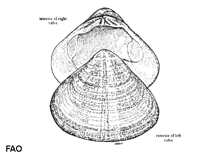Tivela mactroides (Born, 1778)
Trigonal tivela| Native range | All suitable habitat | Point map | Year 2050 |

|
| This map was computer-generated and has not yet been reviewed. |
| Tivela mactroides AquaMaps Data sources: GBIF OBIS |
Classification / Names Common names | Synonyms | CoL | ITIS | WoRMS
Bivalvia | Venerida | Veneridae
Environment: milieu / climate zone / depth range / distribution range Ecology
Benthic; depth range 0 - 2 m (Ref. 83435). Tropical, preferred 27°C (Ref. 107945); 22°N - 29°S, 89°W - 14°W
Distribution Countries | FAO areas | Ecosystems | Occurrences | Introductions
Western Atlantic: from Guatemala to Cuba in the Caribbean, east to Ascension Island and south to Santa Catarina Brazil.
Length at first maturity / Size / Weight / Age
Maturity: Lm ? range ? - ? cm Max length : 3.4 cm DL male/unsexed; (Ref. 83435); common length : 3.8 cm TL male/unsexed; (Ref. 344)
Short description Morphology
Shell heavy, thick, inflated, triangular. Shell surface umbones central and prominent. Hinge with 3 cardinal teeth, with smaller secondary teeth present. Lateral tooth in left valve large. Lunula large, escutcheon absent. Periostracum like varnish. Colour: whitish with brown tinges and rays.
Minimum depth from Ref. 104365. Lives in sand, from the intertidal to very shallow subtidal (Refs. 344, 114796). Shallowly buried in sandy bottoms (Ref. 114795). Abundant near river mouths where organic matter and terrigenous particulates accumulate (Ref. 114796). Suspension feeder (Ref. 78149).
Life cycle and mating behavior Maturity | Reproduction | Spawning | Eggs | Fecundity | Larvae
Members of the class Bivalvia are mostly gonochoric, some are protandric hermaphrodites. Life cycle: Embryos develop into free-swimming trocophore larvae, succeeded by the bivalve veliger, resembling a miniature clam.
Main reference
References | Coordinator | Collaborators
Leal, J.H. 2003. (Ref. 344)
IUCN Red List Status (Ref. 130435)
CITES status (Ref. 108899)
Not Evaluated
CMS (Ref. 116361)
Not Evaluated
Threat to humans
Human uses
Fisheries: commercial
FAO - Fisheries: landings | FishSource | Sea Around Us
Tools
More information
Internet sources
BHL | BOLD Systems | CISTI | DiscoverLife | FAO(Fisheries: ; publication : search) | Fishipedia | GenBank (genome, nucleotide) | GloBI | Gomexsi | Google Books | Google Scholar | Google | PubMed | Tree of Life | Wikipedia (Go, Search) | Zoological Record
Estimates based on models
Preferred temperature
(Ref. 115969): 27.2 - 28.4, mean 27.6 (based on 250 cells).
Prior r = 1.18, 95% CL = 0.78 - 1.77, Based on 1 data-limited stock assessment.
Nutrients: Calcium = 149 [71, 228] mg/100g; Iron = 8.53 [1.95, 15.11] mg/100g; Protein = 9.88 [8.64, 11.12] %; Omega3 = 0.313 [0.202, 0.423] g/100g; Selenium = 61 [50, 72] μg/100g; VitaminA = 0 μg/100g; Zinc = 2.04 [0.56, 3.51] mg/100g (wet weight).



